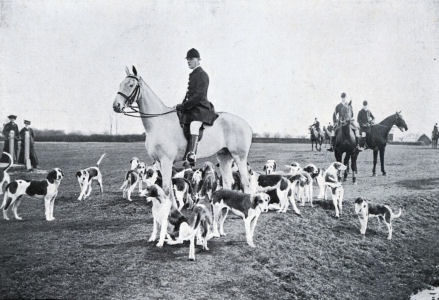|
The
Puckeridge Hunt
|
|
||||||
|
The
Puckeridge Hunt
|
|
||||||

The Puckeridge Hounds
Photograph by Miss Ann Houblon, Hallingbury Place, Bishops Stortford
(The Badminton Magazine, ?, 1904)
Extract from
by M.F.
Hertfordshire Countryside, Summer, 1946
THE Puckeridge Hunt had its origin in a pack of foxhounds (probably one of the first half-dozen packs organised for the chase of the fox, as opposed to that of the deer or the hare) established about 1725 by the Calverts, that very powerful Hertfordshire family of whom it was said, untruthfully but with some justification, that they could walk from Furneux Pelham to Hunsdon on their own land. These hounds became a subscription pack in 1794 and the Calverts retired, much beloved, from active management in 1799, although two members of the family remained as Joint-Masters until 1826.
Mr. Sampson Hanbury, of Poles, a genial brewer, became Master in 1799 and, though he suffered indifferent huntsmen for too long, he founded a tradition of fine sport and careful hound-breeding which has been amply maintained by his successors in office. He resigned in 1832 and Lord Petre, a visitor from the other side of Essex, took the mastership but, not being used to a subscription pack, soon left. In 1835 Mr. Dalyell, a native of Fife, was made Master, but quarrelled with the local farmers and also stayed for only three years.
Nicholas Parry, a Wonderful Sportsman
Eventually, in 1838, the country wisely chose a Master from within its own borders - Mr. Nicholas Parry, of Little Hadham. This wonderful sportsman, who was aged forty-two when he took the hounds, held the mastership for thirty-seven years, until 1875. He was not a rich man tradition states that he never gave a farm-labourer more than sixpence for any small service performed in the hunting field - and his establishment was run on most economical lines. But like Mr. Hanbury, he was a great hound-breeder and, unlike him, a fine judge of a huntservant.
His first huntsman, Dick Simpson (1838-51), a quick little Yorkshireman, showed such sport as has never been recorded in the Puckeridge country either before or since. In his first season, on Dec6mber 1st, 1838, he found a fox at Broadfield, close to Cottered, and killed him at Sandy Warren, having made a fourteen mile point in two hours and a quarter. On March 18th, 1840, he found a fox at Oak Wood (near Sewards End, but now grubbed up) and hunted him n6arly to Halstead, killing him in the parish of Wethersfield after making another fourteen mile point. In those days faxes were few and traveJied far. Dick Simpson had, by our standards, a large number of blank days but, unhampered oy railways, main roads, wire or artificial manures, he killed a large proportion of the faxes found and killed them after fine hunts.
Mr. Parry was succeeded as Master by Mr. Robert Gosling, of Hassobury, father of some of the most loyal Puckeridge supporters of all time. He, also a most knowledgeable foxhunter and a great hound-breeder, hunted the whole country from 1875 to 1885 and a part of it from 1885 to 1890, From 1885 to 1894 there were two rival packs hunting th6 country - an unhappy state of affairs which was ended at last by the appointment to hunt the whole country of tile Hon. L. J, Bathurst, who had already been Master of the Exmoor as a " rusticated " Oxford undergraduate.
The article continues with the a long section on Mr Edward Barclay (master from 1896 to 1946) and details of great hunts of recent years
Sources
The Puckeridge Hunt (Wikipedia)
The Puckeridge Hunt by M.F. (Hertfordshire Countryside, Summer 1946)
A History of the Puckeridge Hunt, by Michael F. Berry, 1950
Portrait of a Hunt: Puckeridge and Newmarket & Thurlow, by Michael Brander